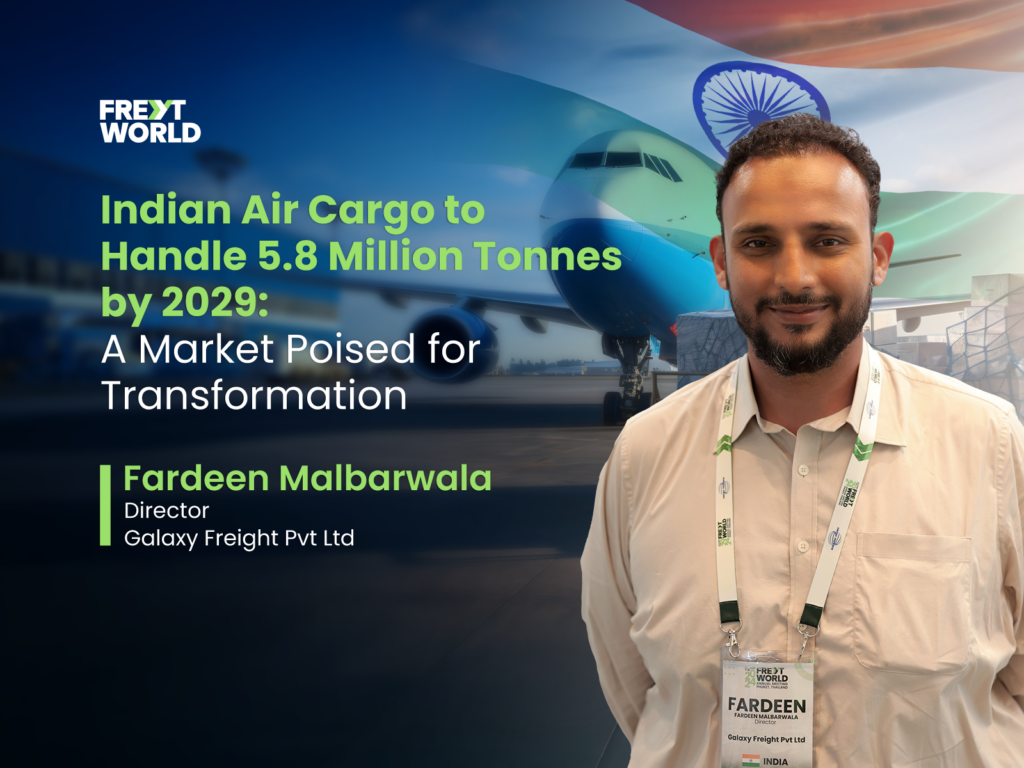26 Feb 2025
Indian Air Cargo to Handle 5.8 Million Tonnes by 2029: A Market Poised for Transformation
By Fardeen Malbarwala, Director of Galaxy Freight Pvt Ltd

India’s air cargo industry is on a remarkable growth trajectory, expected to handle 5.8 million tonnes of cargo by 2029. This ambitious forecast highlights the sector’s pivotal role in the nation’s economic growth and its ability to outperform both global and Asia-Pacific averages. Recent trends show a 19% increase in market performance, driven by the growing demand for efficient, high-speed logistics solutions fueled by domestic consumption, exports, and advancements in infrastructure.
Economic Resilience and E-commerce Expansion
At the heart of this growth is India’s resilient economy, projected to grow by over 6% annually, even amid global economic uncertainties. With the e-commerce market alone expected to reach $350 billion by 2030, the demand for timely and efficient freight solutions has never been greater. India’s dominance in exporting pharmaceuticals, textiles, and engineering goods amplifies the importance of air cargo. Pharmaceuticals account for a significant share of temperature-sensitive shipments.
The government has also stepped up efforts to build a robust logistics ecosystem. The National Logistics Policy (NLP), introduced in 2022, aims to reduce logistics costs from 14% of GDP to 8%. Key initiatives, including the PM Gati Shakti program, have driven investments in airport modernization, multi-modal logistics hubs, and technology integration across supply chains.
India’s airport infrastructure is evolving rapidly. Recent expansions in Delhi, Mumbai, and Bengaluru are complemented by cargo-centric facilities in Tier 2 and Tier 3 cities. Hyderabad’s Rajiv Gandhi International Airport established world-class cargo zones, handling 140,000 tonnes of goods in 2024—a 16% year-on-year increase. This trend signifies the decentralization of air cargo operations, enabling faster delivery to remote regions and unlocking economic opportunities nationwide.
Challenges Facing India's Air Cargo Industry
Despite its strong growth outlook, India’s air cargo industry faces notable challenges. Global inflationary pressures and geopolitical uncertainties, such as trade tensions and fluctuating oil prices, introduce elements of unpredictability. These external factors are compounded by domestic hurdles, including congestion at major airports, insufficient cold chain infrastructure, and regulatory inefficiencies that can delay shipment clearances.
Sustainability has become a critical focus for the sector. Global markets demand lower carbon footprints, pressuring Indian carriers to adopt fuel-efficient aircraft and explore renewable energy solutions. Industry leaders are responding. IndiGo, for instance, has pledged to achieve carbon neutrality by 2050, showing a broader commitment to sustainability.
Opportunities for Logistics Professionals and Freight Forwarders
Amid these challenges, India’s air cargo market presents a wealth of opportunities for logistics professionals and freight forwarders. Additionally, the rapid expansion of e-commerce demands seamless digital solutions. For example, real-time cargo tracking and predictive analytics for supply chain optimization are essential. Consequently, these advancements can significantly enhance efficiency and competitiveness in the industry. Investments in cold chain logistics are growing, with the pharmaceutical industry projected to reach $65 billion by 2025. This fuels demand for temperature-controlled freight solutions.
Regional airports, many of which remain underutilized, hold immense potential for transforming India’s air cargo landscape. Pune’s Lohegaon Airport and Coimbatore International are emerging as critical nodes for regional connectivity. They reduce dependence on overcrowded metropolitan hubs. This enables a more balanced distribution of cargo flows.
India’s air cargo industry is shifting, fueled by economic growth, government support, and technological innovation. Volumes are expected to reach 5.8 million tonnes by 2029. The sector is a cornerstone of India’s $5 trillion economy aspirations.
As the market outperforms global benchmarks, logistics professionals must embrace innovation and sustainability. Industry stakeholders must capitalize on India’s growth story now. Shape the future of a sector as dynamic as the nation. The journey ahead has hurdles, but with strong fundamentals and a clear vision, India’s air cargo industry is well-equipped to navigate the skies of opportunity.

Freyt World Blog Contributor
Freyt World is a global logistics network uniting members from around the world. Our mission is to revolutionize global logistics through collaboration and innovation. Our platform goes beyond networking, enabling members to excel and grow together, featuring articles by logistics professionals for their peers. This series will cover industry-relevant issues and news, providing valuable insights for professionals in the field.


